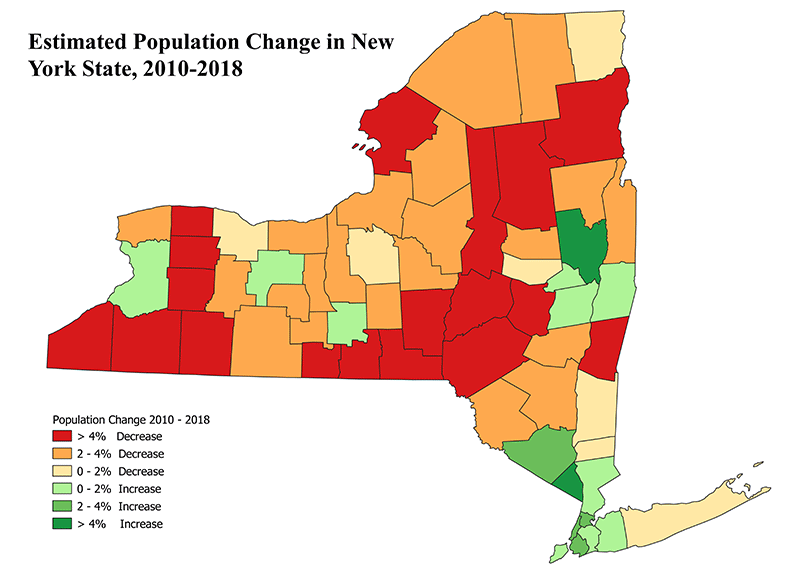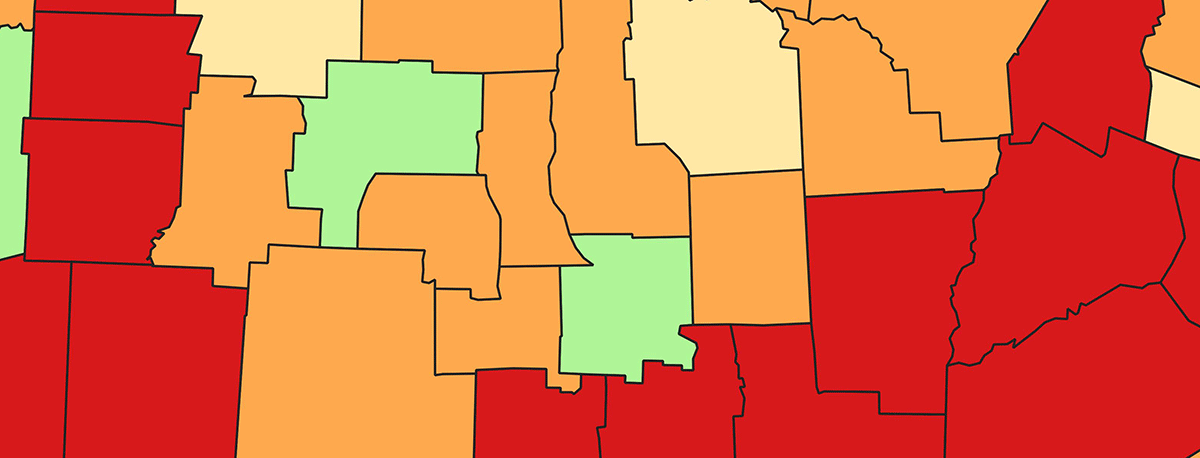The 2018 population estimates by US Census are out, which look at changes in the last decade since 2010. The Census reports that New York’s population in these years is estimated to have grown by around 142,000 people. However, this growth has not been uniform throughout state..
The ten counties of Downstate New York (the three lower Hudson Valley counties of Orange, Rockland and Westchester; the two Long Island counties of Suffolk and Nassau; and the five New York City counties of Richmond, Bronx, New York, Kings and Queens) saw a collective gain of over 250,000 people. All Downstate counties posted gains, with the exception of Suffolk on outer Long Island, which was down by over 13,000 people.
From 2010 to 2018, the Bronx grew by over 44,000 people, Brooklyn (Kings County) by nearly 73,000, Manhattan (New York County) by 40,000 and Queens grew by over 44,000. Westchester, Orange and Rockland counties added nearly 40,000 new residents.
Across Upstate the story was different. The 53 counties of Upstate New York saw a collective loss of over 108,000 people. Just 7 of the 53 Upstate counties saw gains in population from 2010 to 2018. The three Capital District counties of Albany, Schenectady and Rensselaer saw a total gain over 3,600 people, with the lion’s share going to Albany County. Erie County (Buffalo) added almost 600 people, Ontario County, south of Rochester, added 1,700, and Tompkins (Ithaca) added 1,000. Saratoga County was in a league all of its own in Upstate New York in the last decade, adding more than 10,000 new residents.
Eleven of the 12 counties that include parts of the Adirondacks experienced population losses, totaling nearly 23,000, from 2010 to 2018. These 12 counties are home to just over 1 million people. The losses were largely in counties with large areas outside the Adirondack Park, such as Oneida County (-5,186), St. Lawrence (-3,764), Herkimer (-2,628), and Washington (-2,146). Saratoga County was the one county that posted gains with just over 10,000 new residents.
The trends of population gains in urban/metropolitan areas and population losses in rural areas in New York mirrors population trends across the U.S. In 2010, just 6.4% of the U.S. population lived in Rural America, spread across more than 61% of the land area of the lower 48 states. The 2010 Census showed that half of all rural counties experienced population losses, while most urban/metropolitan counties gained population.
These trends have intensified in the last decade, in the wake of the Great Recession, where new employment and population have overwhelmingly shifted to urban/metropolitan areas. There are fewer jobs today in Rural America that there were in 2007, whereas urban/metropolitan areas have added over 10 million new jobs to their 2007 levels.

This map shows areas in New York State that were estimated by the US Census to have gained or lost population from 2010 to 2018.
Recent population loss in Upstate New York followed decades of stagnation. Over the last 28 years, from 1990 to 2018, New York State saw an overall population gain of just over 1.5 million people. The 10 Downstate counties saw a gain of 1,517,839, led by Queens County at 321,000, Kings County (Brooklyn) at 279,000 and the Bronx at 225,000. The 53 counties of Upstate saw a net gain of 3,586.
From 1990 to 2018, the U.S. population grew by 77 million people through births or immigration from abroad. The Downstate New York population grew by just over 1.5 million people in nearly three decades, from 11.4 million to 12.9 million. The 53 Upstate counties netted growth of around 3,600 people, growing from 6,625,181 in 1990 to 6,628,767 in 2018. The country grew by 77 million people, but Upstate New York grew by 3,600. Of the 77 million people who were born in the U.S., or who immigrated here from abroad, in the last 28 years, Upstate New York netted just .0005% of them who chose to make their home here.
From 1990 to 2018, the 12 Adirondack Park counties saw a net gain of 20,710 people. The areas that saw changes mirrored national trends. Oneida County lost over 21,000 and Clinton County saw a drop of over 5,400. Both were likely heavily influenced by closures or significant changes of large military bases. Herkimer and St. Lawrence counties saw long-term losses of over 4,000 each, driven possibly by changes in agricultural production and rural manufacturing. Over that 28-year period, Saratoga picked up almost 48,000 new residents, while Warren, Washington and Franklin also posted significant gains. Saratoga County saw the greatest growth in Upstate.
Times further back saw the script flipped between Upstate and Downstate New York. From 1970 to 1990, the ten Downstate counties experienced a loss of over 400,000 people, with the Bronx (-250,000) and Brooklyn (-300,000) leading the way. In 1990, the Downstate population was 11.4 million and the Upstate population was over 6.6 million. During the 1970s and 1980s, while Downstate was losing population, the Upstate population climbed by over 150,000 people.
It’s highly likely that the trends since the Great Recession, staring in 2008, of mild population losses throughout much of Upstate and significant population gains in Downstate New York will persist. These trends in New York mirror larger national trends of shrinking rural populations and growing urban/metropolitan areas.
As mentioned earlier in this article, about half of all counties in Rural America are experiencing population declines. That means that there are enormous areas in the U.S. where rural communities are planning and strategizing about how to reverse these trends locally and recruit new residents. In the Adirondacks, these efforts are waged against a backdrop of long-term population stagnation and short-term population losses in Upstate New York.
Too much time and energy has been wasted in the Adirondacks in campaigns to weaken environmental protections as some kind of key that will deliver economic development and heightened community prosperity. This flawed theory has been embraced by the Cuomo Administration and is the policy of state agencies. The dynamics playing out in large parts of the Adirondack Park are the same dynamics that are playing out in large parts of Upstate New York and are the same dynamics playing out across large parts of Rural America.






